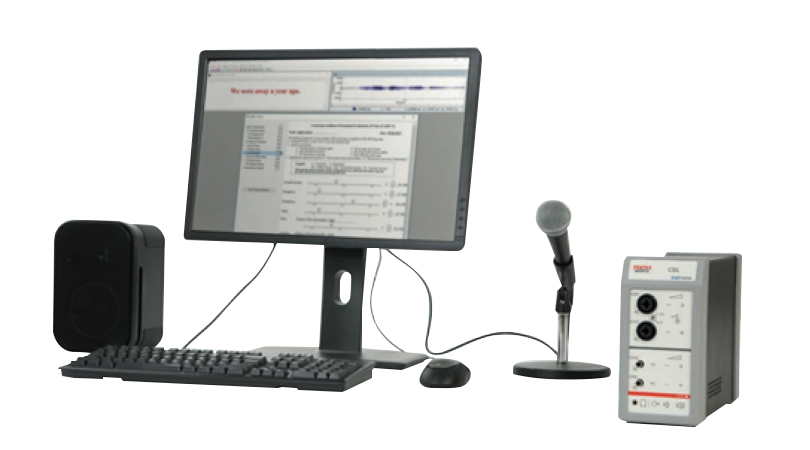1374 阅读 2020-02-21 11:44:03 上传
ok so I realized that we didn't really have much of an opportunity to
look over many spectrogram during class today and so I thought it would be helpful
if we went through an actual spectrogram exercise and if I talked to
through some of the ways in which I approach reading a spectrogram and in this case
thought we'd do an SPHR faculty edition so the spectrogram show you
me reading the name of one of the faculty members here in SPHR
I'm not gonna tell you which one it is you'll probably figured out before we get to the end but it'll be a
a mystery until then
so here's the spectrogram and you can see that at the beginning starting out from brand new spectrogram can
haunting because it can be kind of hard to figure out where to start so when I looked at this
I actually made this recording quite a while ago and I didn't remember
exactly what was represented here so I had to figure it out myself right from the
beginning today so what I did is I started out by thinking well what
first and the first thing that I noticed is we've gotta sound right here and it's got a
after rustic structure to it and those look like formant to me and so the first thing that I did
as I mapped out the formants and I looked at those two formants and I thought well i've got an f1
around five hundred Hertz i've got enough to it's right around twenty-four hundred Hertz that's a
early wide gap that suggests that it's a vowel in the front part of the vowel space but I
not sure exactly where it is that's ok that's all I need to get out of that particular
a part of the spectrogram moving on to the next thing one of the things I
I noticed his right next to that there's something that's also very distinctive here
and that
is an area where you see things that look like they're trying to be formants
but they aren't really getting to be very strong formats in the way that I think
about this is that those format sort of look like crappy formats and
happy format tend to be characteristic of particular kinds of consonant sounds
Sana it sounds in general
with nasals and laterals being the main ones that have this kind of
kind of crappy format you can see there is one format there are about five hundred Hertz and another one maybe
about twelve hundred twelve hundred and fifty Hertz are so
so that's a nice little landmark now the next
the next sound that we have again goes back to having formant and you can see that their
f1 down there around four hundred hurts here show and f2 up there
around twenty five hundred Hertz so when you compare the first vowel we saw to the second
all that we see what I noticed is f1 went down and f2 up
which means that we're going up higher in the front part of the vowel space for
this avowal here to this vowel here
moving forward
what we see is that the next sound has two parts to it the first part is silence
and the second part is a release of that silence followed by a little bit of noisy energy
it doesn't seem to have any vocal fold vibration going on down
as I looked through all of that energy of the release
I noticed that it's not all the same it's relatively light down here but if I look
right here I see a whole bunch of darkness right in that zone
now that zone starts at about fifteen hundred Hertz and it ends around twenty five
it hurts so sort of centered right around two thousand Hertz and that's the akuma
of the energy of that particular burst just from looking at it I
tell that it's a stop and by measuring that band of energy
between fifteen hundred and twenty five hundred Hertz I can tell that the center of that energy is right
around two thousand Hertz and that's characteristic
villar stop in most cases
moving forward the next thing we see is another little vowel but notice how
short this vowel is compared to these other two vowels that makes me think that maybe this is kind of
used vowel perhaps this is an unstressed syllable and we see that we've got a form in
had around five hundred maybe a little over five hundred hurts another formant up at
seventeen hundred eighteen hundred Hertz are so those are kind of in the mid
rangers both formant f1 and formant f2
the next sound we see
is has widely distributed energy and what I noticed
darkest energy is all the way up here at the top and in fact input
it's up above four thousand Hertz is where we really get into the darkness
energy that distributes all the way through the spectrum but it's a notable difference
we up here at the top and when I see energy that centered around four thousand Hertz
in a noisy sound that's usually a good sign that what we're talking about
is some kind of an alveolar freak IV so I'm thinking that this is an alveolar freak IV
the next sound after that
we have again silence followed by a a sudden release so I'm thinking
this is a stop but this time I don't see that same kind of accumulation of energy that I
I hear there's no extra darkness right around here and if anything
a little extra darkness up here now that where you have that extra
centered in the higher frequencies of around four thousand Hertz that's more character
of an alveolar stop and you might notice that there is a consistency between the
energy of the release of an alveolar stop like
and the energy that's accumulated for the alveolar frigate IV something like
that's not a coincidence that's a direct result of the fact that they're both made at alveolar
places of articulation
now the next thing that we see after that stop
another vowel we've got a first formant down
you're maybe at about six hundred Hertz then we've got this second format that's kind of has a trajectory
me that starts up higher and ends down lower if we aim for a mid part of
that we don't we don't know where it's coming from or where it's going so it's hard to tell what the former
auditions are right now but we may be able to say that there's a midpoint
that energy somewhere around two thousand Hertz are so for f2
so I labeled them as may be six hundred Hertz in nineteen hundred Hertz that's
eastern estimate and that's good enough for right now now this next sound that we're going to look at here you all know
crappy formant, formant that look like they're trying to be a vowel but kind of faith
and that's characteristic of either a nasal or a lateral sound and again
you'll notice there is a format
download
sort of crappy looking formant the exact location of these doesn't give you a whole lot of
affirmation but knowing that they're not very good formant tells you that this is some kind
us on a run consonant
the next sound that we have
as I look at it I noticed a lot of similarity between this sound and that sound in that
there's a lot of noisy energy
and there's an accumulation of that noisy energy up here around the four thousand Hertz
and I noticed one thing that looks a little different between this sound
down here what I notice is there's a little bit of evidence that there might
be vocal fold vibration going on some of these striations seemed to be
coming through here and that looks a little bit different than the noise
accumulating down here this does not look like vocal fold vibration where this
like it might be vocal fold vibrations so now I am wondering if this isn't
those are my hypotheses the next thing that I'll look at here
is another vowel and notice how this is a nice short vowel you got two formant that you can identify
they may make you think of these two formant they're pretty similar and in fact it's that short
I will again again I may be thinking of this as another reduced vowel
the next sound
looks very noisy
maybe not too surprising at this point but you'll notice that the darkest area they accumulation
energy is up here in the four thousand Hertz range so it looks like this name is a name that might have
the following sound
what we see are these crappy formant again looking a little bit like this sound
a little bit like this sound so we're thinking that this is us honor an consonant
and no big surprise what's coming up next we've got a vowel very clear f1
very clear f2 there is a little bit of transition that you notice
what may be hard to tell exactly what the format is exactly what the format value is
but you can tell that it's a good strong format trajectory and then finally
there's this here
it's clearly noisy it's not a periodic sound it doesn't look like it's got
any kind of vocal fold vibration and the noise is distributed in a particular way
it's very even from the top of the frequency spectrum down to the lowest
hurt where we see much noise being represented there's no real accumulation of energy
and where we see that kind of wide distribution of a
the energy of noisy energy we tend to think of this as almost
really the idea of is not very likely because there just aren't any words in English
names that I'm aware of that end with the sound
so I'm thinking is either a
sound hear at the end of this word now whose name
that this is actually a sound I think it's a dealer stop and it's clearly a voiceless
of voiceless stop
and here I'm thinking that this might beat
here I'm thinking if this is
I'm thinking this might be because it's a voiced alveolar phr KHA tive and here's another
sound so i've got a few of the sounds and I can start thinking well whose name
corresponds to this so here's a little list of the different faculty members in SPHR
department i've included Nelson ,Nelson who is
not currently ah
down in the basement of new burger but she was on the faculty when I made this spectrogram so she was
in the mix and as I looked through the things that I'm gonna think of I wanna I wanna
that begins with a vowel then has a sonor and consonant and then has another
towel and ideally they would be two vowels in the front part of the vowel space
with this one being just a little bit lower
and this one which would be a little bit higher but both in the front vowel space I would want some
it has a dealer stop
and as I looked through these names there's one name that really kind of stands
I'm not gonna say that name here the other thing I should say actually buh
for I sign off the other thing I should say is this here is actually a pretty good
signature the idea that this may be the last sound in the name
Africa tive we would see an accumulation of energy up here which we don't see so this is probably a
non sibling something like a Ora
turns out there's only one name that ends that way so in fact the answer
to this ends up being reasonably easy
but the process of going through an identifying every single sound
can be very helpful in preparing for doing the kind of spectrogram reading
natural likely have to do as a part of the exam that's coming up so what i'd like to do
yes
turn you
the spectrogram with no annotations on it
and just suggest that you go through from start to finish and see if you can work out
exactly which sound is going on at exactly which point in this spectrum am
and see if you come up with the same answer that I did
thanks very much for watching and enjoy your spectrogram












